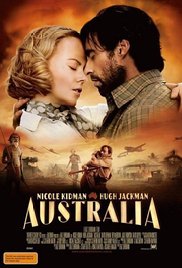 “Australia” feels like three movies rolled into one…three drawn-out movies rolled into one. The first movie involves a WWII-era widowed English aristocrat who inherits a small cattle ranch in the middle of the northern Australian bush (my wife refers to this part as “Out of Australia”). The second part involves the against-the-odds transport of said cattle to the coast in order to thwart the efforts of an opportunistic cattle baron (“Fly Away Cows”?). The final act is what happens to the aristocrat, the rancher she loves, and the mixed-race child she unofficially adopts once the Japanese forces arrive on their shores (“Pearl Harbor Down Under”). It’s all quite cute and wonderfully shot, but it’s not the home run that one might expect from Baz Luhrmann. He just can’t help himself with the teeth-gnashing villains, can he?
“Australia” feels like three movies rolled into one…three drawn-out movies rolled into one. The first movie involves a WWII-era widowed English aristocrat who inherits a small cattle ranch in the middle of the northern Australian bush (my wife refers to this part as “Out of Australia”). The second part involves the against-the-odds transport of said cattle to the coast in order to thwart the efforts of an opportunistic cattle baron (“Fly Away Cows”?). The final act is what happens to the aristocrat, the rancher she loves, and the mixed-race child she unofficially adopts once the Japanese forces arrive on their shores (“Pearl Harbor Down Under”). It’s all quite cute and wonderfully shot, but it’s not the home run that one might expect from Baz Luhrmann. He just can’t help himself with the teeth-gnashing villains, can he?
Nicole Kidman is Lady Sarah Ashley, a cash-strapped aristocrat who suspects her bush-hopping husband is up to no good in Australia, and flies down to confront him. Her driver from the city to the ranch is Drover (Hugh Jackman), an independent contractor of sorts that Lady Ashley convinces to stay on board after she discovers her husband has been murdered by an Aborigine tribesman and her ranch hand, Neil Fletcher (David Wenham), is a mole for local cattle baron King Carney (Bryan Brown). Carney wants Lady Ashley’s land, but Fletcher just wants revenge, and neither is above exploiting the welfare of Ashley’s mixed-race “creamer” boy Nullah (Brandon Walters) in order to get her to knuckle under. (Mixed-race children were separated from society at the time as a means of keeping the blood lines pure.) But Lady Ashley proves to be a ferocious competitor, winning the hearts of Australia’s more free-spirited elite, and ultimately the love of the loveless Drover. That’s when World War II arrives on their doorstep.
It’s an epic story, to be sure, but did it need to be? Luhrmann made a huge time-saving move when he set up the Ashleys as an unhappily married couple from the get-go – let’s get to the movie’s real love story, stat! – but this movie could stand another 20 minutes of trimming. He did the same thing when examining the relationship between Fletcher and Carney. Luhrmann speeds through one thing in order to slow down for another. It’s whiplash-inducing at times.
Luckily for him, he has two extremely charismatic actors at the movie’s center, and they make everything, even the bogged-down bits, watchable. Kidman’s performance is a curious one; she nails the ice queen and rugged outdoorswoman aspects of the role, but doesn’t look very comfortable with the screwball part in between. (Thankfully, it doesn’t last long.) Jackman has it much easier as the man’s man Drover, but you can tell he was just dying to suit up (and shave) for the formal party scene, and Kidman’s reaction to seeing him hosed down for the first time is breathtaking. Newcomer Brandon Walters is cute as a button as Nullah, but his narration – that’s right, the Aborigine child narrates the movie – is dense at times.
Ah, but what to do about Wenham and his hand-wringing, fist-shaking, muah-ha-ha villain Fletcher? By movie’s end, he is a carbon copy of Richard Roxburgh’s Duke in “Moulin Rouge!,” more punching bag than menace. As a result, because his role is underwritten, there is no real tension when Fletcher threatens to ruin Lady Ashley’s plans. Luhrmann needs to close that loophole for his next project.
Still, “Australia” works well enough to recommend, but this will likely be the least-worshiped movie in Luhrmann’s filmography. It’s gorgeous, ambitious, and generally well-acted, but despite pushing the WWII button and the Lost Children button, the movie doesn’t strike the emotional chord of his other work. Which is a pity, since the emotional chord is what defines Luhrmann’s work more than anything.
 (3.5 / 5)
(3.5 / 5)
This originally ran November 26, 2008 on Bullz-Eye.com.



